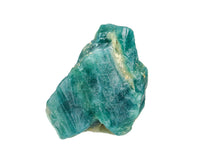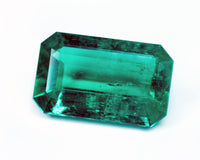- 1. Beryl
- 2. History and Meaning of Beryl
- 3. Physical and Chemical Properties of Beryl
- 4. Varieties of Beryl
- 5. Beryl Healing Properties
- 6. Beryl Metaphysical Properties
- 7. Beryl for Sale
Beryl
Beryl is an exciting family of minerals. With mesmerizing radiance, a wealth of colors, and great hardness, beryl stands out even among its precious peers. It’s a pure pleasure to gaze at the brilliance of its facets. Not only is it an eye candy but also a powerful talisman and a healer. Read further to learn some of the most cherished properties of noble beryls.
History and Meaning of Beryl
Beryl was well known to our ancestors. For the first time, the gem was described by Theophrastus, a student of Aristotle and Plato, in 300 BC. That being said, archaeologists have found beryl jewelry that is thousands of years old. Ancient Egyptians used the mineral to craft beads, and Queen Cleopatra considered green beryls to be her talismans. According to ancient manuscripts, Pliny utilized powdered beryl to treat eye injuries, and healers of the past valued it as a remedy for heart and spine ailments. Beryl is mentioned in the Bible as its crystals adorned the wheels of the Almighty Throne of Glory.
In India, beryl became an embellishment for majestic temples. By the way, the word ‘beryl’ is of Indian origin. Presumably, the stone was found near the Indian city of Belur. According to another version, the name of the mineral comes from the Latin ‘beryllus’ meaning ‘green stone’. But that's not all, one more theory says that beryl is a modified German ‘brille’ meaning glasses. Indeed, in the Middle Ages, monocles featured lenses made of the gem.
Physical and Chemical Properties of Beryl
Beryl is a silicate of beryllium and aluminum with the chemical formula Al2Be3[Si6O18]. Along with that, as it grows, the stone captures a variety of elements including chromium, manganese, iron, etc. These admixtures are responsible for the color of specimens. As a rule, different deposits provide different colors and are slightly dissimilar in their chemical composition.
Most beryls are transparent and have a high refractive index. At the same time, such a variety of the gem as emerald, due to the multiple microcracks, is often cloudy. Polished stones have a vitreous luster, and the hardness of all beryl types is 7.5-8.0 on the Mohs scale.
Varieties of Beryl
The majority of beryl stones are monochromatic, but occasionally, you can come upon iridescent and even cat’s eye (i.e. displaying the optical effect of chatoyancy) specimens. The most common varieties of beryl are the following:
Emerald
• Green beryls are known as emeralds. They are one of the most valued gemstones, and their cost directly depends on the vibrancy of the green color. Bottle green emerald is the most luxurious, while too dark or too light gems are priced cheaply. If a color isn’t strong enough, such a stone isn’t emerald, it is simply green beryl.
Heliodor
• Heliodor is a yellow beryl stone. Discovered only in 1915, it is occasionally referred to as yellow emerald. When heated to 400 °C, heliodor changes its color from yellow-gold to pale blue.
Aquamarine and augustite
• Blue beryl is called Aquamarine and augustite. Despite its undeniable beauty, it fades after being exposed to sunlight for a long time.
• Blue beryl with splashes of green is known as aquamarine. Its colors vary from pale and watery to sky-blue, the latter is often the result of heat treatment. Unlike emeralds, aquamarines have fewer cracks and foreign inclusions.
Morganite
• Morganite is beryl which colors range through yellowish orange, orange, pink, peach, and lilac. These tints are the influence of manganese inclusions. At the same time, morganites of especially saturated colors may be radioactive due to traces of cesium.
bixbite
• The red variety of the mineral - bixbite - is extremely rare and valuable. At first glance, it can be mistaken for ruby, but it tends to feature a crimson tint. Besides, it is often more expensive than ruby.
These are the most widespread types of beryl but lesser-known varieties don’t lag behind when it comes to their look and feel.
Goshenite
• Goshenite is a colorless variety of the gem. It is one of the least expensive beryls.
Bazzite
• Bazzite shows off an intense blue color.
Rosterite
• Rosterite (Vorobyevite) features a high concentration of alkali metals, which color it pink, although colorless specimens are not uncommon.
Beryl Healing Properties
Healers of the past used beryl stones to treat women's diseases. Modern lithotherapists rely on the gem to alleviate the symptoms of nervous system disorders (neuroses, neurasthenia, etc.) as well as ailments of the upper respiratory tract. Apart from that, the stone helps relieve anxiety, strengthens the stomach, improves the functioning of the heart and spine, as well as speeds us recovery after concussion.
You can also use beryl of a specific color to gain additional health benefits:
• yellow beryls eliminate pain in the back and joints. They have a stimulating effect for good measure;
• green gems accelerate metabolism, flush toxins from the body, and normalize the operation of the thyroid gland;
• blue stones help prevent colds, infections, and gynecological diseases.

Beryl Metaphysical Properties
Magicians and parapsychologists appreciate the power of beryl to radiate the energy of love. Talismans and amulets featuring beryl crystals are able to strengthen a family bond, protect from the evil eye, and drive away a negative influence of envious people. The stone becomes a reliable talisman for travelers. It helps find an inexhaustible source of energy within oneself, encourages self-development, and stimulates mental activity.
The energy of the stone fills the one who owns it with courage and confidence. It patronizes purposeful and resourceful people by helping them develop their talents and abilities, and realizing their potential.
Beryl often doubles as a crystal ball or magical object. Fortune tellers use the stone to provide answers to the most important questions related to relationships, work, and spiritual life. The mineral itself is known as the stone of the seer as it develops insight and shrewdness. Apart from that, it assists in finding concentration and removing distractions. Those who possess beryl talismans claim that they help maintain a positive outlook and safeguard from negative energy.
Beryl for Sale
With so many colors, amazing properties, and affordable prices, beryl is much loved across the globe. If you, too, have succumbed to the allure of this gorgeous stone, you ought to have it as your talisman or inlay for your jewelry. Here, at KenKenGems, we have a great many varieties of beryl – beads, strands, individual and loose stones, pendants, and more! Their expertly-made cuts and brilliance will do justice to any piece of hand-made jewelry, while their prices are friendly to your wallet.








